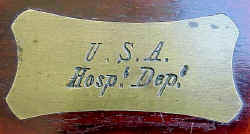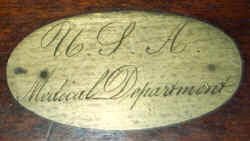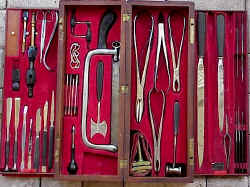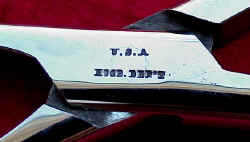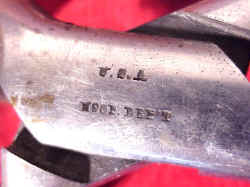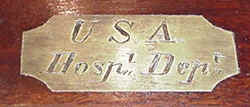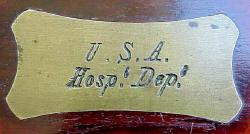Civil War Instrument Makers
Identification of Civil War sets
Civil War Fakes
Information on Civil War surgical sets
Contract Surgeons
Last updated: Monday, December 09, 2024
Also see: Civil War Surgeons identification
U. S. A., Hosp. Dept." U.S.A. Hospl Dept" or "U.S.A. / Medical Department"
Surgical instrument makers during the Civil War: Tiemann, Hernstein, Otto, Reynders, Gemrig, Kern, Snowden, Kolbe, Helmold, Kuemerle, Leypoldt, Teufel, Wirz, Wiegand, Snowden, Codman, Shurtleff, Rees, Wade, Ford, Wocher, Brinkerhoff, Tiencken
What you need to know about Civil War surgical sets How to identify Civil War era surgery sets Identification of Civil War surgeon's Civil War maker labels as found in 61-65 sets Some general information: Obviously there is great interest in American Civil War medical items. Interest is especially high in surgical sets which were actually "used" during the war in the field. Unfortunately, identification of these sets is difficult unless specifically marked with "U. S. A., Hosp. Dept." or "U.S.A. Hospl Dept." or "U.S.A. / Medical Department" for the United States Army, Hospital Department. For more information, see the extensive article on the history of the US Army medical department. The exact history of how surgical instruments and sets were marked “U.S.A. Hosp Dept” is not known. Following the Federal defeat at Manassas and the grim realization that the war may last years and not months, the Army Medical Department, under the auspices of the Quartermaster Department, (the agency responsible for procuring supplies) began purchasing standardize sets and instruments from contract suppliers like Tiemann, Hernstein, Kolbe' and others. Federal government purchased sets: There are two major groups of Federal government contract-ordered surgery sets used during the Civil War:
First, U. S. Army Hospital Department sets, which were specifically made for use during the Civil War. Yes, there were a few Hospital Department marked sets which existed outside the War years, but they are easily identified and dated by the contents. (Note: There are U. S. A. Hosp. Dept. sets used during the Mexican War of 1846, so the trick is to correctly identify the maker and production dates. The Army Medical Department before the Civil War was a small bureaucracy, which consisted of less than 100 doctors, most of whom were not performing surgery on a regular basis as there were no wars, so there were not that many surgical sets needed.)
Secondly, there are U. S. Army Medical Department sets, which were used by Army surgeons before, during, and after the Civil War. With Medical Dept. marked sets you have to figure out when the set was made via the maker address or style of the case and instruments, but the vast majority of these sets were purchased immediately before or during the War. It may have just been a matter of the small group of doctors in the pre-war Medical Department ordering military surgical sets out of a different budget than the budget created to run the whole War effort and assigned to the Hospital Department bureaucracy.
A minor category of 'government', but not Federal, military sets are those purchased by the volunteer state militia's. A
minor source of military
'style' sets are those from various state voluntary militias
existing prior to and during the Civil War. These state groups,
which were later mustered into the Regular Army, could have
ordered military-style sets for their own use prior to or even
during the War. The instrument makers made sets for
the state militia groups before the War or during the first year
before the Med. or Hosp. Dept. purveyors ordered the 4,000 sets
for the Federal Army. This
would account for the small number of military sets we see from
regional makers like Rees, Brinkerhoff, Goulding, Otto,
Shurtleff, etc. These regional makers could have provided
military-style sets for their local militia volunteers, but were
never under contract to supply the main-stream sets ordered and
used by the Union Army during the War due to their inability to
supply the large numbers or quality of instruments.
Remember, the vast majority of instrument makers in 1861, other than someone like Tiemann, were not geared for large scale production, but rather crafted individual hand-made instruments which were custom ordered by the surgeon or put-up in cases for sale as a design by 'doctor so-and-so'. Other 'makers' imported instruments from England and France to assemble sets as requested by a given doctor or retail outlet such as a pharmacy or apothecary dealer. It is possible any given military group could have contracted with any given instrument maker to provide a set of instruments for their group with military latches and military dedicated instruments. The markings or lack there-of on the brass plates or instruments would be the telling point. Only the official Union ordered sets would be engraved and marked as U.S.A. Hosp. Dept or Medical Dept. All others would be either unmarked or otherwise marked. This may account for some un-marked brass plates during or prior to the War years. The Union government, through Surgeon Richard S. Satterlee as Medical Purveyor of the United States Army, contracted with various makers in the Northeast like George Tiemann of New York and Dietrich W. Kolbe' of Philadelphia to make specific types of instruments and field surgical sets. These sets were actually used in the War by the Union's field troops and rear area hospitals. These same instrument makers supplied the pre- and post-war medical community in all areas of the continental U.S. Therefore, it becomes important to "date" a given set to document its ownership. There were a large number of doctors who served on both sides during the war and they required access to instruments of the profession. The Union's troops were supplied by some of the best known instrument makers in the United States, while the Confederate supplies were often from smaller makers in the South, earlier sets, or were imports from France, England, and other European makers. Only the Federal provisioners are marked as 'U.S.A., Hosp. Dept.' and are "official" government produced sets or individual items. The fact the Confederate's instruments were perhaps from European or Southern origin is not to say they were inferior by any means. The European makers were in business long before the American makers and in many cases of better quality. It's just that the Union's medical supplies were organized and ordered to specification. Proving an amputation or surgical kit was used in the Civil War is difficult at best. Unless the name "U.S.A. Hospital Department" or "U. S. Medical Department", or the documented variation appears on the item, you need extensive information and documents to attribute a given set to the Civil War. Antique dealers are fond of calling anything old "Civil War Antiques", but the fact is few are authentic. The name and address of the manufacturer is a key to dating the item. Many sets are stamped with the makers name and the dates they were in business can provide information as to the period of use. At the bottom of this page is a list of Civil War instrument makers. See: Instrument sets specified by the U.S. Army Medical Department during the Civil War
U. S. Army Hospital Department and Medical Department inscriptions In general, due to the time frame of 1860-1865 when actual Civil War material would have been made, most of the hand instruments like the surgical knives will have non-metal handles. Non-metal means: rubber, ivory, ebonized wood, bone, horn, gutta percha, etc.. All-metal handles were not used until after the 1870's, so any wood cased or leather pouched minor surgical set with all metal handled instruments will not be from the Civil War era. All too often an antique dealer will label a small leather cased set with all metal handles as being from the Civil War and that is just not the case. Obviously, if a given instrument maker didn't exist prior to the Civil War or the address on the instrument case of the maker dates post Civil War, then the instruments could not have been a part of the Civil War. Also, if the doctor didn't graduate until after the War, then...well you get the idea. It is known that contract doctors used their own pre-existing surgical instruments during the war, but unless there is actual documentation from the time, that would be very difficult to prove. This is why there are instruments and sets which date prior to 1860 which may or may not have been used in the War. Unless you can provide absolute proof that a given 'contract' doctor owned and used a given set during the War, you are making a mistake to call it a 'Civil War' set. You can call it a Civil War 'era' set, but then anything made prior to 1860 could make that claim. To be safe, don't pay a premium for any set unless the seller can provide absolute and positive proof of use and ownership. Given the high dollars involved in true or real Civil War sets, fakes are not uncommon, and liars are plentiful. We can get some idea of the numbers of contract and 'regular' military doctors during the War and assume that many of contract doctors would have provided their own surgical sets. The following information is from: A History of the Army Medical Department: Civil War Medicine 1861-1865 by Mary C. Gilletty
How often amputation was performed can be determined from the following account by Gilletty:
Often, personally owned surgical sets were engraved with the doctor's name on the top of the wood surgical instrument case and that would be especially helpful in tracking down the actual user and time frame. There are extensive documents on almost all the doctors who served in the War, so it is possible for an expert or historical researcher to determine authenticity should that be desirable. Before you pay extra for provenance, do the research. (Note: I personally do not collect sets just for provenance. It's too dangerous to the pocket book and more than likely someone made up the story anyway.) After the War, many doctors moved out West and purchased surgical sets to take with them. Just because a given doctor served on either side during the War doesn't mean he used a given set in the War. The same goes for the later "Indian Wars" era. However, it may be a case of a given set was owned by a Civil War doctor, but the use of that set in the war will be questionable unless the set is marked as having been produced for the U. S. Army. Is this getting any clearer? The point I'm trying to make is that authentic, documented Civil War sets are rare and the odds of one turning up at a weekend local auction are slim and none. Just because a set was made by one of the listed Civil War contract makers is no guarantee it was used in the Civil War. Just because an auction house makes the claim that a set is 'Civil War' don't believe it. Research and dates are your best friend. If you are going to claim a set was used in the Civil War, you better have some extensive documentation and even if you have a marked set, you have to make dead sure the engraving is not faked. Fakes are being made because Civil War sets bring a premium. See the photos below. The other problem with many of the "Civil War" sets is missing instruments and substitutions in the set. Often parts are missing from any set, but war-time issue is particularly subject to loss. Fortunately or unfortunately, depending on your perspective, the instruments were more standardized for the contracted sets and the odds of finding a replacement part is better than for finding one for an individually handcrafted set. As is the case with most velvet lined wood cased surgical sets, the wood cases were made specifically for a given instrument and the fit of the given instrument to the case is generally perfect. If someone tries to substitute an instrument, then it is usually obvious or not consistent with the time-frame of the set. The Civil War instrument manufactures, in many cases, were contracted by the Union government's Army Medical Department to supply the Army with specified surgical sets and may or may not be marked "U.S.A. Hospl Dept." or "USA Hospital Department". There are also earlier sets marked U. S. A. Medical Dept. For example, in a war specified set one would expect a "bullet" extractor would be a part of that specification and would be found in the set. On the other hand, not many general amputation sets have a bullet extractor. By deduction, if you find an amputation set with a bullet extractor of a certain type, you may expect it was used during a time when bullets were flying, but that doesn't mean it was used in the Civil War. The Civil War contract sets are very utilitarian and not the fancy ivory handled sets or presentation sets sold to "famous" doctors in a professionally competitive place like New York. The list of makers listed below are not the only providers, but some of the more notable. Some of these manufacturers existed prior to and after the War. The trick is to figure out which ones were suppliers to both sides during the War. The wood cases for real" Civil War" commercially made sets will be in military type boxes. The wood boxes usually, have double lateral sliding locks on the front of the case, not central keyed locks. Central keyed locked sets are generally civilian issue. (Finding the 'key' during a battlefield experience would have presented some difficulty.) Some military sets with a single sliding lock have surfaced. The boxes were made of high quality mahogany and not fruitwood or some other wood that would fracture when wet. The military sets generally have a brass cartouche on the top of the box which will be inscribed with the United States Army Hospital Department insignia of some sort. Some of the instruments will also be marked with the insignia of the Department. The military sets are in general similar in lay-out of the instruments and all will have a velvet type of lining. The urethral instruments will be the longer type for use on males. One point of confusion about military sets is the marking on the top of the sets. It can be "USA Medical Department" or "USA Hosp. Dept." To the best of my knowledge, the sets marked "Medical Department" can be pre- or post- Civil War as they were made for and owned by the existing military. The Medical Department existed after the Revolutionary War (created in 1818) and lasted until well after the Civil War. They owned surgical sets which were in existence before, during, and after the Civil War. Those sets marked "Hosp. Dept." can be pre-Civil War or issued during the Civil War by and for the Army's Hospital Department. The term 'Hospital Department' actually precedes the 'Medical Department' as the Hospital department was in existence during the Revolutionary War and the into the War of 1812. After 1812, congress created the 'Medical Department' which oversaw the Hospital Department. Confused? It is not uncommon for Civil War medical items to be found in a general Civil War collection. Therefore, those collectors may be major preservers of "real" sets. Since there are far more general Civil War collections, the likelihood of a large number of medical sets being in those collections is important. To date, the only public catalog of American surgical sets has been accumulated by Dr. Edmonson and presented in his book on American Surgical Instruments. This is an area where the Civil War collectors could help with the knowledge base by contributing detailed photos of their sets for publication of these important artifacts. I am currently making plans to collect this data for general use via this site. Anyone wishing to contribute photos may contact me via this site. From what I have seen by their purchases on eBay, Civil War reenactors are not typically using sets or instruments actually used during the War. They are typically using just about any era surgical set to stage their acts. Authenticity is not necessary for acting as it is for collecting. I'm sure there are reenactors with correct sets, but it is not necessary to use authentic sets or instruments to provide a historical drama. Hopefully reenactors appreciate the necessity to preserve these valuable artifacts and not subject them to loss or damage during staged productions. The type of knife and shape of the blade in the amputation kit can be telling. The straight blade amputation knife replaced the curved or circular style blade about the time of the Civil War. Circular amputation blades would more than likely be earlier. Pre-1840's kits tend to be much more fancy and ornate too. The ones actually used in the War are generally in pretty rough condition as are the cases in which they were stored. Buying an 'authentic' Civil War item at auction is a study in foolishness. You better know a lot to do it and get a guarantee with written return privileges from the seller or auctioneer. A word of warning: there are reproduction amputation kits out there. Some of them were made by E.G. Archer & Son, Surgical Instrument Co., Knoxville, Tenn. These are fine for "Civil War reenactors", but not for collectors. As previously mentioned, all too often, antique dealers will attribute a medical item as being "Civil War" . This is very difficult to ascertain without extensive documentation. The fact that an item existed at the time of the Civil War is not necessarily reason to say it was used in the Civil War. Remember, many of the manufacturers existed prior to and after the war. Often it is the address of manufacture printed on an item that will tell you the date range during which that item was made. Name, associates, and address changes are a way to narrow the time and usage of a given instrument or case. This is where Edmonson's American Surgical Instruments book is so helpful as it painstakingly charts the addresses and dates of all American manufacturers of the time. A few statistics from Edmonson's book...to give you an idea of the number of sets ordered for the War by the United States Army and to help figure the odds of one showing up now as well as rarity:
Listed are some (not all) of the known Civil War instrument makers as reported by James M. Edmonson, Ph.D., in his book: American Surgical Instruments, a directory of makers to 1900. See the books and references page for the publisher of this essential book.
|
||||||||||||||||||||||
